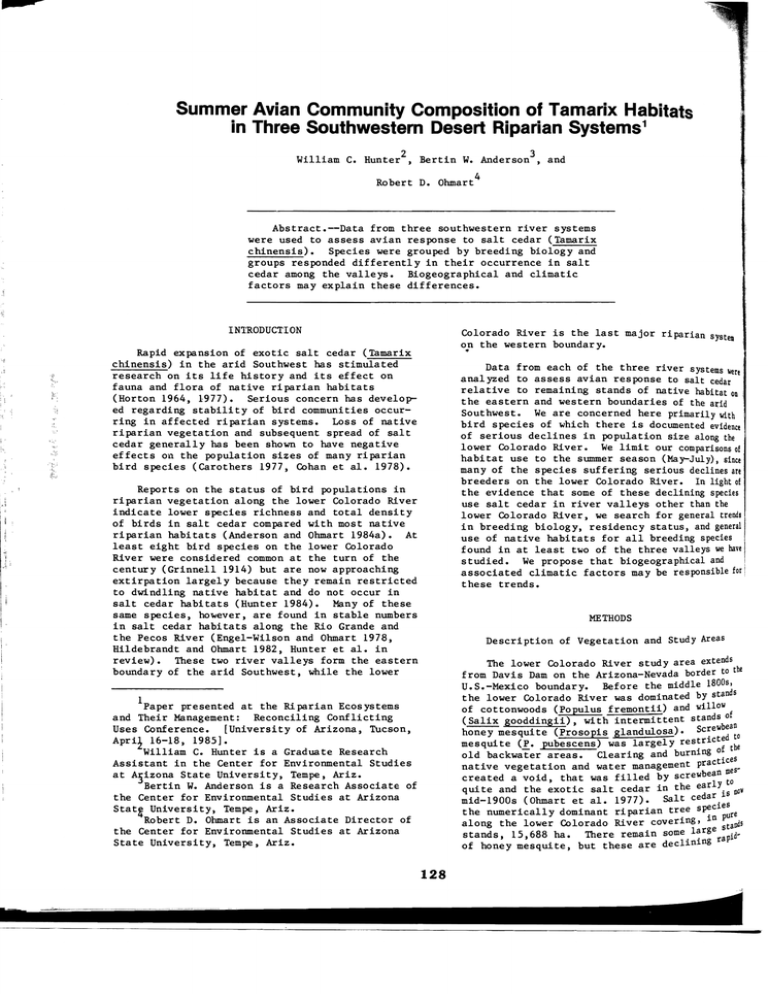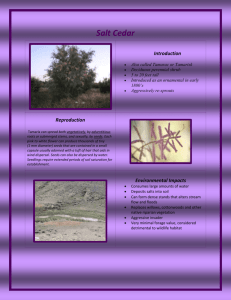Summer Avian Community Composition of Tamarix ... in Three Southwestern Desert Riparian ...
advertisement

Summer Avian Community Composition of Tamarix Habitats in Three Southwestern Desert Riparian Systems 1 2 3 William C. Hunter , Bertin W. Anderson , and Robert D. Ohmart 4 Abstract.--Data from three southwestern river systems were used to assess avian response to salt cedar (Tamarix chinensis). Species were grouped by breeding biology and groups responded differently in their occurrence in salt cedar among the valleys. Biogeographical and climatic factors may explain these differences. INTRODUCTION Colorado River is the last major riparian systel o.n the western boundary. Rapid expansion of exotic salt cedar (Tamarix chinensis) in the arid Southwest has stimulated research on its life history and its effect on fauna and flora of native riparian habitats (Horton 1964, 1977). Serious concern has develop­ ed regarding stability of bird communities occur­ ring in affected riparian systems. Loss of native riparian vegetation and subsequent spread of salt cedar generally has been shown to have negative effects on the population sizes of many riparian bird species (Carothers 1977, Cohan et al. 1978). Data from each of the three river systems liere analyzed to assess avian response to salt cedar relative to remaining stands of native habitat ou the eastern and western boundaries of the al;'id Southwest. We are concerned here primarily "With bird species of which there is documented evidence of serious declines in population size along the lower Colorado River. We limit our comparisons of habi tat use to the summer season (May-July), since many of the species suffering serious declines are breeders on the lower Colorado River. In light of the evidence that some of these declining species use salt cedar in river valleys other than the lower Colorado River, we search for general trends in breeding biology, residency status, and general use of native habitats for all breeding species found in at least two of the three valleys we have studied. We propose that biogeographical and associated climatic factors may be responsible for these trends. Reports on the status of bird populations in riparian vegetation along the lower Colorado River indicate lower species richness and total density of birds in salt cedar compared with most native riparian habitats (Anderson and Ohmart 1984a). At least eight bird species on the lower Colorado River were considered common at the turn of the century (Grinnell 1914) but are now approaching extirpation largely because they remain restricted to dwindling native habitat and do not occur in salt cedar habitats (Hunter 1984). Many of these same species, however, are found in stable numbers in salt cedar habitats along the Rio Grande and the Pecos River (Engel-Wilson and Ohmart 1978, Hildebrandt and Ohmart 1982, Hunter et al. in review). These two river valleys form the eastern boundary of the arid Southwest, while the lower METHODS Description of Vegetation and Study Areas The lower Colorado River study area extends h from Davis Dam on the Arizona-Nevada border to t e U.S.-Mexico boundary. Before the middle l80GS d the lower Colorado River was dominated by stan s of cottonwoods (Populus fremontii) and willoW f (Salix gooddingii), with intermittent stands boan - - -mesquite ) Screw honey (Prosopis gland ul osa. . de to ctef the 1 restU ) 1 mesquite (P. pubescens was arge y old backwater areas. Clearing and burning ~ices native vegetation and water management prac Illes' created a void, that was filled by screwbealD to . the ear quite and the exotic salt ce da,r l.n d yis nOw mid-1900s (Ohmart et a1. 1977). Salt ce a\es the numerically dominant riparian tree sp~~ pure along the lower Colorado River covering, stand! stands, 15,688 ha. There remain some. ~~::e rapid­ of honey mesquite, but these are decll. 1paper presented at the Riparian Ecosystems and Their Management: Reconciling Conflicting Uses Conference. [University of Arizona, Tucson, Apri 16-18, 1985]. William C. Hunter is a Graduate Research Assistant in the Center for Environmental Studies at A3izona State University, Tempe, Ariz. Bertin W. Anderson is a Research Associate of the Center for Environmental Studies at Arizona Stat~ University, Tempe, Ariz. Robert D. Ohmart is an Associate Director of the Center for Environmental Studies at Arizona State University, Tempe, Ariz. t 128 observations and supported by life-history data (Bent 1964, Phillips et ale 1964, Anderson and Ohmart 1984a). Pure cottonwood stands, estimated to encom• 2,000 ha in the 1600s, now cover less than ha (Anderson and Ohmart 1984b). Two lines of analysis were followed after classifying birds into the above categories. The first was to determine the proportion of bird den­ sity per unit area in each major plant community among the three river valleys. This was found by equally weighting, by area, each plant community and calculating the percentage of birds that would be found from density estimates. These propor­ tions do not reflect the distribution of individ­ uals among the present distribution of plant com­ munities, but rather they refer to the relative importance of each plant community to bird abun­ dance in each river valley. This allows for direct comparison of the relative importance of salt cedar to bird species in each river valley in relation to available native habitats. The lower Rio Grande study area extends from Quitman to Presidio, Texas. As on the lower o River, the lower Rio Grande was naturally by cottonwood, willow, and honey mes­ until clearing for agriculture removed t all of this native vegetation (Engel-Wilson Ohma rt 1978). Presently, only 12 ha of mature habitat remain intact. Salt is the dominant phreatophyte on the lower comprising, in a monoculture state, at 64% (5,600 ha) of the total vegetation -Wilson and Ohmart 1978). The middle Pecos River study area extends from t Sumner, New Mexico to Pecos, Texas. Histori­ accounts dating back to the 1600s indicate the middle Pecos River valley was devoid of riparian vegetation except for isolated tonwood bosques near Roswell and Fort Sumn ~r, Mexico (Hilcebrandt and Ohmart 1982). HOlley te is found throughout the valley, but high­ ructured stands only occur in the southern of the study area. Presently, salt cedar is principal riparian tree along the Pecos River, sing 22,800 ha in New Mexico, and 87,200 Texas (Pecos River Basin Water Salvage 1979). The above approach does not take into account differences in structure type for each community in each river valley. Since there were differ­ ences in the amount and kind of structure types found in each valley, a second line of analysis was needed. Due to limitations in space, we pre­ sent only data .for the salt cedar habitats found in each valley. We combined salt cedar transects to stress the average height of the canopy layer in terms of >4.5 m, 0.6-4.5 m, and 0.0-0.6 m. The Rio Grande lacks salt cedar with the peak canopy layer <0.6 m; whereas the Pecos River lacks salt cedar with a canopy height >4.5 m. However, all river valleys have salt cedar with canopy heights between 0.6 and 4.5 m (this is the most often encountered type of salt cedar along other south­ western riparian systems). Data Collection censusing was conducted in all major plant communities following a modified (1971) variable-distance line transect tech­ (Anderson and Ohmart 1984). Each of the s (100 along the Colorado River, 21 along Grande, and 30 along the Pecos River) was three times monthly. Densities were cal­ for the summer season (nine censuses for transect) and expressed as birds/40 ha. ~~U5eC:L5 were classified into plant community­ types. Plant communities were identi­ the dominant tree species and included :ott:onwo()d--willow, honey mesquite, screwbean mes­ (lower Colorado River only), and salt cedar. types were defined by the proportion of foliage density at each of three vertical Bird densities per month were transformed by taking log IOn + 1 of the density and averaged from transects for salt cedar with 0.0-0.6 m, 0.6-4.5 m, and >4.5 m peak canopy heights both within and among river systems. Duncan's Multiple Range test for variable log of abundance (Zar 1974) was applied to arrange and separate or group salt cedar habitats with an a"0.05 for each bird species. In this way, we could determine the rel­ ative importance of average canopy height of salt cedar stands as well as differences among river valleys in the actual densities of birds in salt cedar. All data were co]jlected by personnel trained . the lower Colorado River field laboratory, allowed for direct comparison of data among Data are for four summers from the lower River (1977-80), one summer from the Rio (1977), and one summer from the Pecos River Details concerning these and other field .",nlrl1.as employed are presented in Anderson and (1984a) • RESULTS Use of Salt Cedar Within Valleys Seven species occurring in at least two of the studied valleys were determined to be midsummer migratory breeders. All of these species arrive in large numbers no earlier than April with the latest species to arrive, the Yellow-billed Cuckoo (Coccyzus americanus), appearing by early June. All of these species are open-cup nesters, and all leave the breeding areas by September. Six of the seven midsummer migratory breeders are found on the Colorado River and five show a clear prefer­ ence for the cottonwood-willow community on this river system (table 1). Two species, the Western Analysis Bird species were grouped into three main cat­ es based on their peak breeding period. se groups were (l) migratory midsummer breed­ , (2) migratory spring and early-summer breedand (3) resident spring and early-summer rs. These criteria were judged by our field 129 ii, ,'j " Iii Table 1.--Proportion of bird populations in plant community types on the lower Colorado River, middle Pecos River, and lower Rio Grande, scaled within valleys. A clear preference for a community is indicated by underlining. A species absence from a river valley is indicated by a dash. CW m Cottonwood-willow; SC = salt cedar; HM = honey mesquite, SM = screwbean mesquite. Proportion of population per unit area Colorado Breeding category/species Pecos Rio Grande Time of residency CW SC HM SM CW SC HM CW SC Jun-Aug 68 2 20 10 53 45 2 54 9 37 Apr-Sep 60 27 6 7 67 18 15 34 0 66 Apr-Sep 67 0 33 0 15 37 48 May-Aug 84 8 2 6 42 58 0 51 35 14 May-Sep 98 2 0 0 87 13 0 28 39 33 May-Sep 42 30 4 24 41 55 4 43 23 34 0 82 18 47 28 25 72 11 17 10 44 46 11 49 40 8M MIDSUMMER MIGRATORY Yellow-billed Cuckoo Western Kingbird (Tyrannus verticalis) Bell Vireo (Vireo belli!) Yellow-breasted Chat (Icteria virens) Summer Tanager (Piranga rubra) Blue Grosbeak (Guiraca caerulea) Painted Bunting (Passerina ciris) May-Sep SPRING AND EARLY SUMMER MIGRATORY Ash-throated Flycatcher (Myiarchus cinerascens) Lucy Warbler (Vermivora luciae) Brown-headed Cowbird (Molothrus ater) Northern Oriole (Icterus galbula) Mar-Oct 21 13 35 31 Mar-Jul 15 27 33 25 Mar-Jul 33 26 14 27 22 65 13 55 28 17 Mar-Jul 47 12 22 19 71 26 3 40 20 40 Permanent 17 26 30 27 8 75 17 16 12 72 Permanent 47 7 20 26 80 13 7 46 31 23 Permanent 23 14 31 32 0 0 100 4 9 87 Permanent 26 6 58 10 0 0 100 0 0 100 Permanent 10 16 39 35 0 5 95 Permanent 52 13 22 13 56 34 10 20 16 64 Permanent 19 18 44 19 7 64 29 0 13 87 0 18 82 0 0 100 SPRING AND EARLY SUMMER RESIDENTS Greater Roadrunner (Geococcyx californianus) Ladder-backed Woodpecker (Picoides scalaris) Verdin (Auriparus flaviceps) Cactus Wren (Campylorhynchus brunneicapillus) Black-tailed Gnatcatcher (Polioptila melanura) Northern Mockingbird (~ polyglottos) Crissal Thrasher (Toxostoma crissale) Pyrrhuloxia (Cardinalis sinuatus) Permanent 130 ~rd and Blue Grosbeak occur in the salt cedar ty to some extent, but the other species largely absent from salt cedar. In contrast, same species on the Rio Grande and Pecos occur in greater proportions in salt cedar with native plant communities, with the of the Western Kingbird. Only two of cies show clear preferences for cottonwood- on the Pecos River. The migratory midsum­ breeding species are not as restricted to the low community on the Pecos River and Grande as they are on the Colorado River. Four species were classified as migratory and early summer breeders. These species by late March and all but the Ash-throated leave the breeding areas by July. The Cowbird is a nest parasite and does ~ild its own nest. The other three species protective nests placed in tree cavities or ted to conceal the eggs. No clear prefer­ patterns exist in any plant community for any valley in this category (table 1). The salt community is not avoided in any of the river by any of these species. 7 6 8 4 3 4 5 6 o 7 ,0 2 3 Eight species were classified as resident and early summer breeders. At least four begin breeding activities by mid-February. of these species produce multiple broods with last young fledging by July. Five of the species build open-cup nests, two build nests, and one uses cavities for nesting. of eight species are restricted to the honey community on the Rio Grande, with only r-backed Woodpecker showing higher pro­ occurrence in the cottonwood-willow com­ (table 1). The Ladder-backed Woodpecker is species in this category to occur consis­ in higher proportions in the cottonwood­ community in each river valley. This prob­ relates to easier excavation of cavities in and willows, compared with honey mes­ salt cedar. The Greater Roadrunner and Thrasher show very high proportional use cedar on the Pecos River in contrast to use of this plant community on the Rio and Colorado River. The Verdin, Cactus , and Black-tailed Gnatcatcher show stronger ion to honey mesquite on the Rio Grande Pecos River, on the Southwest's eastern systems, than they do on the Colorado which represents the most western riparian 7 species on the Pecos River at this canopy height (P<0.05, table 2). Two species in this breeding category, Blue Grosbeak and Western Kingbird, occurred in as high or higher density on the Colo­ rado River than found on the Pecos River and the Rio Grande, respectively. Three of four migratory spring and early-summer breeders were found to have significantly higher densities on the Colora­ do River; only the Brown-headed Cowbird was not found to differ in density among the three river valleys. Four of seven resident spring and early­ summer breeders occurring on the lower Colorado River were found in significantly higher densities there. Greater Roadrunner and Ladder-backed Wood­ pecker densities were high on the Colorado but were not different from the Pecos River and Rio Grande, respectively. For both the second and third breeding categories, only Northern Mocking­ bird occurred in significantly lower densities on the Colorado River than found in the other two river systems. In summary, five of six species of migratory mid-summer breeders have significantly lower densities on the Colorado River when com­ pared with the Rio Grande and/or Pecos River; whereas, nine of 11 spring and early-summer breed­ ing species occurring on the Colorado River were found in significantly lower densities on the Rio Grande and/or Pecos River. In salt cedar with average canopy heights >4.5 m, four of seven migratory midsummer breeding species have significantly higher densities on the Rio Grande than on the Colorado River. Two species, Western Kingbird and Blue Grosbeak, have significantly higher densities on the Colorado River. Only one of 11 spring and early-summer breeders (including both migratory and resident) on the Colorado River was found in significantly lower densities than on the Rio Grande. Salt cedar with average canopy height 0.0-0.6 m has three of five migratory midsummer breeders, mutually occurring on both the Pecos and Colorado rivers, with significantly higher densities on the Pecos River. All migratory midsummer breeders have lower densities on the Colorado River. The Northern Mockingbird was, as at the other two can­ opy heights,' the only spring and early-summer breeder to be found in significantly lower densi­ ties on the Colorado River. DISCUSSION Comparing Salt Cedar Use Among Valleys Use of Salt Cedar Among Valleys o 5 4 7 o No species was found to use salt cedar among valleys consistently, in relation to structure type or in use of native plant communities. The Ladder-backed Woodpecker, Blue Grosbeak, and Brown-headed Cowbird were species in which reason­ able predictions could be made on use of salt cedar in all river systems from knowledge of only one river system. Therefore, applying data from one river system for use of salt cedar will lead to serious errors in management on other river systems for most riparian bird species. Proportion of bird densities per unit area in plant community reported above does not take account differences in structure types found each river system. Below we present results trends found in bird occurrence in salt cedar tion to the average canopy height layer in river valley. ~e report first on the average canopy layer 0.6-4.5 m since it was found in each river ley. Four migratory midsummer breeding insect­ have significantly higher densities in salt On the Rio Grande wi th an additional three Data on Bell Vireos can be used as a possible source for such errors. The Bell Vireo on the 131 Table 2.--Relative use of salt cedar at three levels of canopy height by birds on the lower Colorado River (CR), lower Rio Grande (RG), and middle Pecos River (PR). Bird densities transformed to 10gI0n+l/40 ha. Significant values are derived from Duncan's Multiple Range Test for variable logs of abundance (Ott 1977), a~ 0.05. A species absence from a river valley is indicated by a dash. Bird density in canopy layer height levels 0.6-4.5 m Breeding category/ species >4.5 m CR RG PR CR 0.000 0.560 0.000 0.634 0.000 1.260 a 0.301 0.000 1.148 a 1.860 a 1.108 a 1.048 1.233 a 0.975 a 0.877 a 0.810 a 1.457 a 1.203 a 1.513 0.602 0.983 0.301 1.437 0.360 0.634 a 0.634 a 0.950 a 0.492 a 0.816 a 0.752 a 0.201 0.100 a 0.593 b 0.534 0.000 0.359 0.233 b 0.560 0.301 0.774 a 0.301 0.000 0.000 0.0-0.6 m RG CR PR MIDSUMMER MIGRATORY Yellow-billed Cuckoo Western Kingbird Bell Vireo Yellow-breasted Chat Summer Tanager Blue Grosbeak Painted Bunting 0.911 b 0.301 1.377 a 0.783 0.000 0.861 a 0.000 0.301 0.810 1.026 a 0.301 a 0.000 0.736 a 1.743 a 1.450 a 0.715 1.038 0.000 0.418 a 0.360 1.133 a 0.000 0.000 0.000 0.000 0.259 0.901 1.085 0.000 0.885 a 1.967 a 1.012 a 1.363 0.259 0.703 0.301 1.397 0.699 a 1.002 0.661 1.227 0.418 0.502 a 0.593 a 1.171 a 0.301 a 0.725 a 0.560 a 0.201 0.100 0.201 0.000 0.000 0.000 0.100 0.761 a 0.159 0.519 0.360 0.952 a 0.418 a 0.842 0.678 0.301 0.735 0.201 0.000 0.000 SPRING AND EARLY SUMMER MIGRATORY I:" Ash-throated Flycatcher Lucy Warbler Northern Oriole Brown-headed Cowbird 0~641b 1.373 0.761 1.170 SPRING AND EARLY SUMMER RESIDENT , ~ Greater Roadrunner Ladder-backed Woodpecker Verdin Cactus Wren Black-tailed Gnatcatcher Crissal Thrasher Northern Mockingbird Pyrrhuloxia 0~579b 1.533 a 0.259 0.667 1.390 a 0.301 aDenotes significantly higher abundance compared with same canopy height level in other river valleys. bAbundance significantly lower than a but significantly higher than the remaining river valley. lower Colorado River is nearly extirpated as a breeding species; although, at the turn of the century it was listed by Grinnell (1914) as among the most characteristic birds in the willow­ cottonwood association. This species fails to use pure salt cedar stands on the lower Colorado River but still occurs and breeds rarely in salt cedar mixed with honey mesquite as well as remaining cottonwood-willow stands. On the Rio Grande, this species occurs in high densities and uses pure salt cedar. Therefore, it has remained common in this river valley. In addition, Bell Vireos are spreading in the Grand Canyon coincidental to the spread of salt cedar along the Colorado River (Brown et ale 1983); however, salt cedar in this area forms a narrow band adjacent to the mesquite belt which is similar to salt cedar-honey mesquite mix habitats where we find Bell Vireos on the lower portion of the river. If we wanted to man­ age for Bell Vireos on the lower Colorado River Id based on Rio Grande or Grand Canyon data, we wou · species show that salt cedar is acceptable to t h 1S and might recommend that salt cedar not be clear­ ed, in fact, we might encourage its proliferati~:. Given the present Bell Vireo density in pure cedar habitats on the lower Colorado River (0/ ha), this would be a serious mistake. The same can be said for Summer Tanagers based on Rio s:O 132 he ,.. may not allow the permanent resident species to spread into alternative riparian habitats such as salt cedar and survive to breed the next year. As one proceeds from west to east winters become more severe, but where winters are less severe (as on the Colorado River) and, at least during some years, when food resources remain high, individ­ uals forced into "suboptimal" habitats may survive to breed the next year (Anderson et al. 1982). data and Yellow-billed Cuckoos from Pecos ta. All three of these species are in danger of extirpation from the lower River. o River data alone would indicate that ty of birds do not use salt cedar in op Ortions compared with native plant com­ Thus, we might recommend that clearing • from other river valleys would not ser­ impact riparian bird populations. However, species on the Rio Grande and Pecos there would be serious impac.ts if native communi ties were not restored where sal t was to be cleared. The important point here each river valley should be surveyed for of riparian habitats available and how species responds to each habitat; rely­ data from geographically distant river sys­ even different portions of the same river are unacceptable options. These data suggest that enviromnental extremes, such as seasonal temperature, may be important in a species' ability to use all avail­ able habitats. We are observing groups of species with similar habitat preferences and with similar breeding biology becoming restricted in the same way in their use of habitats. The response to salt cedar may be linked to the abilities of these species to cope with extreme physiological condi­ tions and not only to the presence or absence of interspecific compe·tition for limited nesting space or food resources (Carothers et al. 1974). Data on relative insulation properties of salt cedar, insect biomass, and relative bird use of salt cedar along an east-west gradient are needed to help clarify these points. The Gila River, in Arizona, presently is under study to investigate further the trends presented here. )0 59 85 Biogeographical Considerations DO ~tterns 18 61 70 35 01 100 100 in bird occurrence in salt cedar the three river sytems are considered y. Two patterns that do exist are (1) midsummer breeding species are largely to cottonwood-willow and avoid salt on the Colorado River and (2) resident and early-summer residents are restricted mesquite and avoid salt cedar on the Rio • Since the Pecos River is a major tribu­ to the Rio Grande and these rivers together the eastermnost riparian zones in the arid st, we contrast data from these two rivers from the lower Colorado River. Several patterns emerge representing the entire •.OUULllwcst by comparing eastern and western ACKNOWLEDGMENTS Dr. J. Rice was instrumental in assisting-with data analysis and interpretation. Field work was accomplished by many dedicated 1:iologists to whom we are grateful. We thank J. R. Durham and C. D. Zisner for editing assistance. C. D. Zisner also typed the manuscript. The research was funded by the U.S. Bureau of Reclamation Contracts No. 9-07-57-V0567 and 7-07-30-V0009 and the Interna­ tional Boundary and Water Commission Contract No. IBWC IBM77-17. cies that are migratory midsummer breeders lower Colorado River may be associated with broadleaf riparian forests because they tolerate lower-statured salt cedar or other habitats (i.e., honey mesquite and open of cottonwood-willow) that do not provide a foliage cover to protect these (and/or their eggs and young) from thermal In fact, all bird species that occur in salt cedar on the lower Colorado during summer (1:eside doves; see Walsberg 5-Ro berts 1983) begin nesting ea rly in the (March through June) and/ or have covered • Elevational gradient lowers from east to . and in the arid Southwest average summer become higher so that the lower Colo­ represents the extreme summer environ­ LITERATURE CITED Anderson, B. W., and R. D. Ohmart. 1984a. Vegetation management study for the enhancement of wildlife along the lower Colorado River. Comprehensive Final Report to U.S. Bureau of Reclamation, Boulder City, Nev. 529 p. Anderson, B. W., and R. D. Ohmart. 1984b. Vegetation type maps of the lower Colorado River from Davis Dam to the southerly international boundary, update 1982. Bureau of Reclamation, Lower Colorado Region, Boulder City, Nev. Anderson, B. W., R. D. Ohmart, and S. D. Fretwell. 1982. Evidence of social regulations in some riparian bird populations. American Naturalist 120:340-352. Bent, A. C. 1964. Life histories of North American birds. Dover Publications, Inc., New York, N.Y. Brown, B. T., S. W. Carothers, and R. R. Johnson. 1983. Breeding range expansion of Bell's Vireos in Grand Canyon, Arizona. Condor 85:499-500. and resident spring and early-summer species show a trend of declining use of from west to east. Many of these Occur in salt cedar and other plant com­ on the lower Colorado River but become restricted to honey mesquite on the Rio and Pecos River. These species are primar­ and Chihuahuan desert species. Cold in western Texas and eastern New Mexico 133 Carothers, S. w. 1977. Importance, preservation and management of riparian habitat: an overview. p.2-4. In Importance, preservation and management of riparian habitat: a symposium. [Tucson, Ariz., July 9, 1977] USDA Forest Service General Technical Report RM-43, 217 p. Rocky Mountain Forest and Range Experiment Station, Fort Collins, Colo. Carothers, S. W., R. R. Johnson, and S. W. Aitchison. 1974. Population structure and social organization of southwestern riparian birds. American Zoologist 14:97-108. Cohan, D. R., B. W. Anderson, and R. D. Ohmart. 1978. Avian population responses to salt cedar along the lower Colorado River. p. 371-382. In Strategies for protection and management-of floodplain wetlands and other riparian ecosystems. [Callaway Gardens, Ga., December 11-13, 1978] USDA Forest Service General Technical Report WO-12, 410 p. USDA Forest Service, Washington, D.C. Emlen, J. T. 1971. Population densities of birds derived from transect counts. Auk 88:323-342. Engel-Wilson, R. W., and R. D. Ohmart. 1978. Floral and attendant faunal changes on the lower Rio Grande between Fort Quitman and Presidio, Texas. p. 139-147. In Strategies for protection and management oY-floodplain wetlands and other riparian ecosystems. [Callaway Gardens, Ga., December 11-13, 1978] USDA Forest Service General Technical Report WO-12, 410 p. USDA Forest Service, Washington, D.C. Grinnell, J. 1914. An account of the mammals and birds of the lower Colorado River valley with especial reference to the distributional problems presented. University of California Publications in Zoology 12:51-294. Hildebrandt, T. D., and R. D. Ohmart. 1982. Biological resource inventory (vegetation and wildlife) -- Pecos River Basin, New Mexico and Texas. Final Report to U"S Bur eau of Reclamation, 160 p. + 24 maps Am Horton, J. S. 1964 • Notes on the• fnt arin 0, Te deciduous-tamarisk. USDA Forest SrOduction Research Note RM-16, 7 p. Rocky MerVice Forest an d Range Experiment StationOuntain Collins, Colo. ' Fort Horton, J. S. 1977. The development and perpetuation of the permanent tamarisk the phrea tophyte zone of the Southw tYPe 124-127. In Importance, preservat':St. p. management-0f ' riparian habitat: a slOU and [Tucson, Ariz., July 9, 1977] USDA YmFpOSiUq Serv i ce Genera I Technical Report RM-43orest 217 Rocky Mountain Forest and Range Experi~e Sta t ion, Fort Collins, Colo. nt Hunter, W. C. 1984. Status of nine bird specie . I o f speCla concern along the Colorado Rt Wildlife Management Administrative Re ver. POrt No 8 4 -A, California Department of Fish and G Nongame Wildlife Investigations, Sacra ame Cali f. mento, Ohmart, R. D., W. o. Deason, and C. Burke. 1977 A riparian case history: the Colorado River p. 35-46. In Importance, preservation and management of riparian habitat: a sYmpostUll [Tucson, Ariz., July 9, 1977] USDA Forest Service General Technical Report RM-43, 217 Rocky ,Mountain Forest and Range Experiment Station, Fort Collins, Colo. Pecos River Basin Water Salvage Project. 1979. Final environmental statement. U.S. Bureau Reclamation Regional Office, Southwest Regia Amarillo, Tex. Phillips, A. R., J. Marshall, and G. Monson. 1964. The birds of Arizona. 212 p. University of Arizona Press, Tucson, Ariz. Walsberg, G., and K. A. Voss-Roberts. 1983. Incubation in desert-nesting doves: mechanisms for egg cooling. Physiological Zoology 56:88-93. Zar, J. H. 1974. Bios ta tistical analysis. Prentice-Hall, Englewood Cliffs, N.J. 620 f





